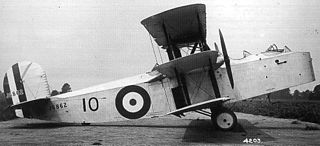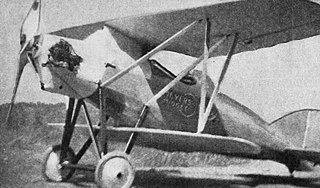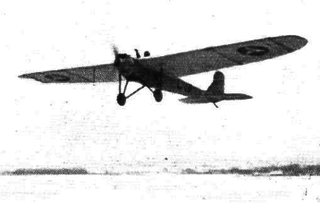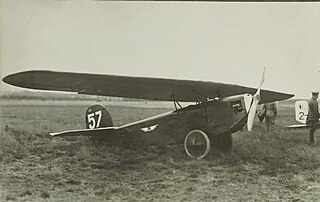
Klemm L 25, later Klemm Kl 25 was a successful German light leisure, sports and training monoplane aircraft, developed in 1928. More than 600 aircraft were built, and manufacturing licenses were sold to the United Kingdom and the United States.

The Parnall Possum was an experimental triplane, with a single, central engine driving wing-mounted propellers via shafts and gears. Two of these British aircraft were built in the mid-1920s.

The Meyers Midget was a one-off small, low-powered, sporting single-seat sesquiplane, designed and built in the United States in 1926, incorporating several innovative structural features.

The LFG V 39 was a simple biplane trainer built in Germany in the mid-1920s. It took part in the Round Germany Flight in the summer of 1925.

The LFG Roland Pfeilflieger, (Arrow-flyer), was a German swept wing, single engine, two seat biplane built in Germany in 1914. It made one distinguished long duration flight and served in colonial German South-West Africa.

The Daimler L15, sometimes later known as the Daimler-Klemm L15 or the Klemm-Daimler L15 was an early two-seat low-powered light aircraft intended to popularise flying. In mid-career it flew as a glider.

The Daimler L20, later known as the Klemm-Daimler L20, was one of the first light aircraft to be built in significant numbers. A two-seater with an engine of only 20 hp (15 kW), it demonstrated the ability of a small aircraft to cope with flights over the Alps in winter and to make transcontinental journeys of over 36,000 km.
The Ruhrtaler Ru.3 was a German advanced single-seat trainer designed to take pilots to combat standards. Initial flying tests showed promise but the owner of Ruhrtaler cancelled all aeronautical activity after his son was killed whilst demonstrating the Ru.3 to the Air Ministry.

The 1923 Feiro I was the first Hungarian designed and built civil transport aircraft, modified in 1925 by an engine change into the Feiru Daru (Crane). Neither was a commercial success.
The Potez 51 was a 1930s French intermediate trainer, intended to replace the ageing Potez 25 which had sold worldwide. It did not go into production.
The S.A.B.C.A. S.XII or S.A.B.C.A S.12 was a four-passenger light transport aircraft with three engines and a high wing, built in Belgium in the early 1930s.
The Bréguet Colibri was a low power, single seat French monoplane designed to compete in a 1923 newspaper-sponsored contest between such aircraft. Only one was built.

The parasol wing, single engine Udet U 8, sometimes referred to as the Limousine, was a three-seat commercial passenger transport designed and built in Germany in 1924. Five were produced and were used by German airlines until about 1928.

The Udet U 7 Kolibri (Hummingbird) was a single engine, single seat, parasol wing light aircraft, designed and built in Germany in the mid-1920s. Though they had some competition success and set an unofficial lightplane duration record, only two were produced.
The Muniz M-5 was the first of Antonio Guedez Muniz's aircraft designs to fly; soon afterwards he became the first Brazilian to design an aircraft which reached series production. The sole example of the M-5, built while he was a student in France by Caudron, was a low wing cabin tourer or military liaison aircraft.
The Offierski O.2 was a one-off, two seat, low powered lightplane built in Poland on the late 1920s. It flew in 1928 but an old and unreliable engine prevented its development.
The Silesia S-4 was a Polish, low-power parasol wing aircraft built in 1925. After an engine change and airframe modifications it became one of the Silesian Aeroclubs fleet. It was lost in a take-off accident in 1931 and was the last Silesia aircraft to fly.
The Grzmilas Orkan II was a Polish one-off, single-seat sports aircraft. It came second in the second National Lightplane Contest held soon after its first flight, with outstanding take-off and climb characteristics. Its designer and builder continued to use it until 1939.
Kawanishi's first aircraft, the Kawanishi K-1, was designed as a mail carrier. It was the first Japanese aircraft to receive a Certificate of Airworthiness from the Aviation Bureau. It won a prize in a national contest but was not a commercial success and only one was built.
The Fukunaga Tenryu 10 was the largest Japanese civil passenger aircraft when it first flew in 1922. Its passenger cabin seated four.












